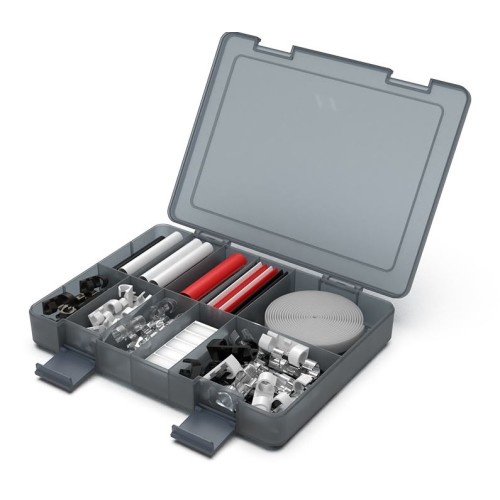
A thoroughly supplied toolbox is a craftsman's primary asset for basic jobs such as gauging material to fastening screws accurately. This guide will equip you with the knowledge to select the right tools and utilize them effectively.
- Commence by gathering a core array of hand tools: hammer, screwdriver, wrench, pliers, saw, tape measure.
- Become familiar with tool functionality and the unique contexts where they apply.
- Practice your techniques through hands-on projects, gradually increasing the complexity.
Keep in mind investing effort to master hand tools builds your craftsmanship. With thorough expertise, tools will enhance your capacity to deliver precise, demanding project outcomes.
Amplify Productivity with Power Tools
Ready to transform your projects? Delve into the amazing world of power tools, where precision and efficiency converge. These core power tools can radically improve results for both pros and amateurs. From high-torque drills to fine-detail saws, power tools supply varied functions to manage construction jobs easily.
- Employ cordless impact drivers for fast and effortless fastening and demo activities.
- Utilize reciprocating saws for efficient, clean cuts across diverse materials.
- Improve woodworking outcomes via strong planers and jointers providing fine finishes.
Adopt power tools to quicken delivery and produce superior outcomes.
Accuracy Simplified
In a world where detail reigns supreme, the right measuring tools can make all the difference. From basic rulers to professional laser devices, measurement equipment empowers precise design execution. Whether skilled craftsman or curious beginner, mastering measurement devices expands capabilities.
- Explore the diverse range of measuring tools available for every need.
- Familiarize yourself with applications and advantages of each measuring device.
- Develop your skills in accurate measurement and application.
Kits for Every Job
Whether you're a seasoned professional or a DIY enthusiast, having the right tool set is essential for tackling any project. For diverse tasks including assembly and fastening, the perfect toolset supports accuracy and safety. Match toolset choice to the tasks you undertake most frequently.
Should you opt for an extensive set or a more targeted kit? Having clarified demands, investigate various brands to compare specs, quality and pricing. Check online user reviews to obtain helpful input before finalizing your selection.
Using careful research and forethought you can select a toolset to tackle tasks with assurance.
Caring for Hand Tools to Maximize Lifespan
Keeping hand tools well-maintained is necessary for any dedicated craftsman. Avoid neglect—unmaintained tools produce dull blades, defects and poor experiences. Sustained care maintains tools in top condition for prolonged reliable use. Post-use cleaning removes dust and debris to protect tools. Keep tools stored dry to avoid rust and corrosion.
- Use a sharpening stone or file to regularly restore blade edges.
- Treat moving parts with suitable oil to decrease wear and friction.
- Inspect handles for cracks or damage and replace them as needed.

Observing these care recommendations extends tool life and results in better, more efficient work.
Basic Hand Tools Every Home Workshop Needs
A complete workshop becomes an inviting workspace for enthusiasts and hobbyists. Although specialized gear benefits projects, foundational hand tools are indispensable. A must-have selection includes a reliable hammer, a versatile adjustable wrench, and a sturdy tape measure for accurate measurements. Include varied screwdriver sizes, pliers for gripping and a utility blade for cutting work. A sturdy saw is key for precise cuts and a level guarantees aligned, even work.
- Key Hand Tools for DIY Workspaces

Comprehensive Guide to Power Tool Safety
Power tools are high-powered tools that yield considerable efficiency and force. However, they mandate a detailed understanding of safety protocols. Overlooking protection protocols can cause dangerous injuries. This compendium explains power tool safety, offering knowledge to ensure secure operation.
Kick off by learning your tools—read manuals thoroughly and absorb the specific safety features. Regularly wear PPE like safety glasses, earmuffs and protective gloves. Service tools periodically to guarantee optimal performance.
Bear in mind safety is the top priority in any workshop environment. Complying with these precautions ensures you can use power tools safely and with confidence.
Picking Accurate Measuring Tools
When pursuing precise measurement outcomes, tool selection yields a major impact. Multiple types of measuring devices are offered, each built for distinct tasks. Grasping features of each tool is crucial to pick wisely. Consider elements like accuracy, resolution and scale when picking the appropriate measuring tool.
- For length measuring tasks, a tape measure or ruler is generally used.
- For angles, a protractor is an indispensable tool.
- Calipers—especially digital—are perfect for measuring small features.
By carefully selecting the appropriate measuring tools, you can ensure accurate and reliable results.
Choosing The Ultimate Tool Set

Choosing the right tool set can be an exciting but daunting task. Given an abundance of options, decisions can become overwhelming. This complete guide supplies the knowledge to determine the best set for requirements.
First and foremost, consider the type of projects you'll be undertaking. Are you advanced or an amateur? Specific goal-setting simplifies choice.
- Blend both tool types where appropriate to maximize productivity and precision Don't be afraid to combine blend utilize both power and hand tools for a successful productive efficient outcome Blend both tool types where appropriate to maximize productivity and precision
- Give precedence to core necessary tools
- A sturdy hammer or mallet including a sledgehammer
- Screwdrivers plus wrench and plier collections form a crucial versatile set
- Tape measure or ruler for measuring
- Level Plumb Bob Transit
Further considerations include the materials used in the construction of the tools, your budget constraints, and brand reputation. Recall that durable toolsets offer long-run value.
DIY Made Simple: Using Tools Effectively
Starting out on a DIY project can feel like a big step. But don't worry—using suitable tools and some know-how makes tough tasks manageable. Commence by familiarizing yourself and learning tool functions. Peruse manuals thoroughly and practice techniques in a safe space. Make safety your principal and immediate concern. Put on safety gear—eye protection, gloves and hearing protection—to reduce risk.
In tool choice, prioritize sturdy construction and reliable quality. Buy from dependable brands that provide durability and longevity.
Ask for tips from experienced DIYers or professionals at nearby hardware outlets. Store pros and experienced DIYers can share practical suggestions and insights for picking ideal tools.
- A maintained sharp edge equals safer tool use—keep blades honed.
- Keep tools stored and organized to avoid misplacement and harm.
- Be open to attempting new projects to grow skills
Deciding on Power or Hand Tools for Tasks
For workshop projects, the decision between power and hand tools can be perplexing. Although heavy-duty power tools excel in speed and efficiency, hand tools remain valuable for finesse and small tasks. Use the following overview to choose the correct tool category for your project.
- Hand tools provide superior control for detailed assembly, carving and intricate repairs. These tools offer heightened control and usually come at a lower cost.
- When speed is key—cutting, drilling or sanding—power tools deliver quick, efficient results. They significantly lower manual labor and shorten project timelines.
In conclusion, the best tool option is based on task specifics, user experience and budgetary constraints. Combine hand and power tools strategically for successful and efficient project completion.
